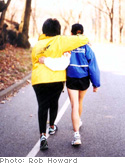Oprah Talks to the Central Park Jogger

Note: This interview originally appeared in the April 2002 issue of O, The Oprah Magazine. Later that year, the convictions of those charged in the attack were overturned based on DNA evidence.
On April 19, 1989, a 28-year-old investment banker left her office for a jog through Central Park. Before she headed out, she invited a coworker to drop by her apartment on Manhattan's Upper East Side later that night. "I'm going for a run," she told him. "I'll be back by ten."But when he arrived, she wasn't home—nor would she come home for months. Just before ten that night, as she was passing through a remote section of the park, she was brutally assaulted. A pack of at least six teenage boys raped her, beat her unconscious, dragged her body to a ravine, and pummeled her with rocks and pipes. At 1:30 in the morning, two passersby found her with her mouth gagged, her hands tethered with a long-sleeve shirt, and wearing only a bra. Her body temperature had plummeted to about 80 degrees and she had lost nearly three quarters of her blood.
Within days the case of the Central Park jogger (the media generally withholds the names of rape victims) had ignited a fiery racial controversy. The six boys who were indicted for rape, assault, and attempted murder were minorities, while the jogger was Caucasian. Five of them were under age 16, and all were from middle-class families and had no previous police records. The boys who were under 16 were sentenced to five to ten years in jail, the maximum for juveniles, while the sole defendant who was over 16 received 5 to 15 years. But since none of the DNA evidence placed the teenagers at the crime scene, some people believed the victim's then-boyfriend was responsible. Both sides saw the attack as a symbol of the violence and racial tension that pervaded New York City.
As the jogger lay in a coma for 12 days, barely hanging on to life, the world followed the headlines charting her prognosis, and people around the country joined in prayer. "She was battered and bruised on every part of her body except for the soles of her feet," recalls Elizabeth Lederer, the prosecutor who handled the case and visited the jogger in the hospital. "Her head was in a bandage turban. Her face was swollen. She had tubes in her mouth and nose. To see someone so gratuitously injured just broke your heart."
But four months after receiving last rites, she was actually running again. And although her head injuries left her with no memory of the attack, she decided she had to face the defendants in court. "I didn't want her to go through anything more," says Lederer, who confirms that all six have completed their sentences and have been released from prison. "But I felt it was important for the jury to hear from her about the injuries she'd suffered. And there was a lot of spin out there—some people portrayed her as this icy and impersonal investment banker. Others were suggesting she was dealing drugs in the park. Some said she had rough sex with her boyfriend in the park. In the end it was an empowering experience for her to testify and participate in the process that would hold people responsible for what they did to her. She made me appreciate the power of survival and the belief and hope of recovery. She's a very determined woman."
In 1995 the jogger marked her ultimate triumph by running in the New York City Marathon. Now 41, she lives in a suburb of Connecticut and works for a nonprofit organization; she has been married for five years, with no children. On the day we met, the only visible sign of her ordeal was a jagged scar near her eye. First she jogged with me near the site where she had been left for dead. Then she broke her long-standing silence with the media and told me her story.
Start reading Oprah's interview with the Central Park Jogger



